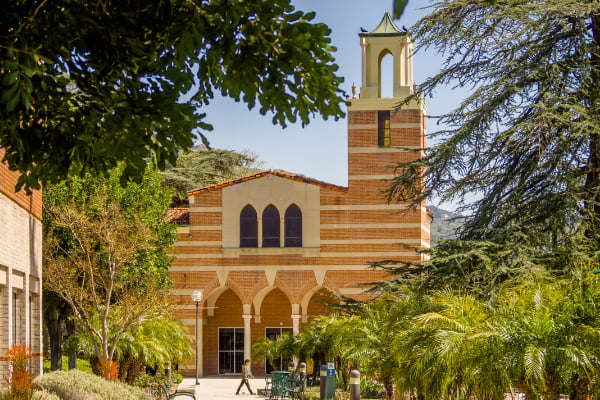University of Redlands Emergency Alert System
Alert Received: . For more information, visit: https://www.redlands.edu/alert/
University of Redlands
Approval marks the beginning of a transformative chapter for two historic Southern California universities.

REDLANDS, CALIF., June 4, 2024 -- The University of Redlands has finalized its acquisition and integration of Burbank-based Woodbury University, creating an academic portfolio that maximizes strengths and efficiencies, and reinforces both Woodbury’s and Redlands’ positions as leaders in higher education.
As a result of the integration, the University of Redlands will add dynamic programs such as architecture, interior and fashion design, filmmaking, animation, and game design to its existing innovative programs in the arts and sciences, business, education, and theology.
“In today’s competitive higher education landscape, we must explore innovative ways to grow by offering new programs that are in high demand by students and employers,” said University of Redlands President, Krista L. Newkirk. “By joining together, our shared academic portfolio will enable us to create a progressive and compelling environment where our combined impact is greater than what either institution can do alone.”
University of Redlands Chair of the Board of Trustees, Jamison J. Ashby added, “Woodbury offers immediate access to excellent academic programs which complement those presently offered by Redlands. This acquisition is entirely consistent with our strategic plan, further strengthening our stature as a leading private liberal arts and professional university in the West.”
This acquisition marks Redlands’ third in four years. In 2020, it acquired the San Francisco Theological Seminary, establishing its campus in Marin County. In May of 2023, it solidified a merger with San Francisco-based Presidio Graduate School and its pioneering MBA and MPA programs in sustainable solutions, which will become a signature program within Redlands’ School of Business and Society.
In December of 2023, Redlands announced its intent to acquire Woodbury, highlighting its highly sought-after programs in architecture, animation, gaming art and design, fashion design, interior design, and filmmaking. Since that announcement, both universities have hosted numerous sessions with students, staff, alumni, and trustees to provide information, encourage relationship-building, and ensure a smooth transition for all stakeholders involved.
Greg Lippe, Chair of the Woodbury Board of Trustees, concluded, “We eagerly anticipate this next chapter in the legacy of Woodbury University. We are excited about and grateful for the University of Redlands’ desire to partner with us and to develop our joint future in a collaborative and energetic manner.”
As part of the agreement, Woodbury University continues to operate with its current name and becomes a subsidiary of the University of Redlands, as approved by the WASC Senior College and University Commission (WSCUC), with full integration anticipated pending approval from the U.S. Department of Education and accreditors. Upon final approval by the Department of Education, Woodbury will complete its integration into Redlands while maintaining the legacy of its name in relation to the Burbank campus and its distinct academic programs. The integration plan fosters collaboration between the two universities to explore new programs, leveraging their respective academic expertise.
About the University of Redlands
Founded in 1907, the University of Redlands is a private, nonprofit university that has prepared students for lives of meaning, impact, and joy for more than 100 years. Today, Redlands offers over 40 undergraduate programs and over 30 graduate programs designed to develop students personally and professionally through immersive, personalized education and hands-on experiences outside of the classroom, from community service learning to internships and residencies. Learn more at redlands.edu.
About Woodbury University
Founded in 1884, Woodbury is one of the oldest universities on the west coast of the United States. A private, nonprofit institution located in the Southern California city of Burbank, Woodbury is at the global epicenter of creativity and influence. With a low student-to-faculty ratio, students learn from one of the most professionally accomplished faculties in the world, intern and work at the most innovative companies in the world, and go on to build solid careers. To learn more about Woodbury, visit woodbury.edu.
Woodbury University has been exploring a university affiliation to enhance their financial stability and create additional opportunities for its students, and the University of Redlands emerged as the leading choice.
For the University of Redlands, it will expand on the range of educational pursuits by offering access to Woodbury University’s unique degree programs and an additional campus location just minutes away from the heart of the Southern California creative community.
Our strategic plan, Forward Together, focuses on offering new programs that today’s students seek, growing opportunities for underserved student populations, and further ensuring financial sustainability. The integration of Woodbury into the University of Redlands furthers these initiatives while providing more opportunity for you.
Woodbury University’s interests are in preserving and enhancing the longstanding Woodbury educational experience by merging with a university that is aligned with their mission and values. As part of this, Woodbury students will have the opportunity to expand their educational experience with access to the University of Redlands academic programs, student services, study abroad programs and campuses through California and in Salzburg, Austria.
Our intent is for University of Redlands students to gain access to Woodbury University’s distinctive programs in architecture, animation, business, media production, and design, among others. It also adds another campus location in Burbank, just minutes away from the heart of the entertainment industry.
This change would not impact University of Redlands’ curricular or co-curricular requirements, location, or availability to students.
The first phase of the merger should be accomplished by June of 2024 (pending WSCUC approval). The second phase of the merger is subject to completion of the processes required by the U.S. Department of Education, which can take 1-2 years.